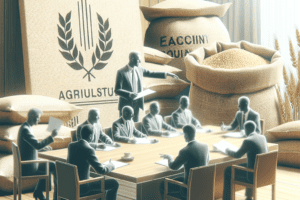Exporting grain from landlocked countries presents a unique set of challenges that can significantly impact agricultural economies. These nations, surrounded by land and lacking direct access to ocean ports, face logistical, infrastructural, and economic hurdles that complicate the export process. Understanding these challenges is crucial for policymakers, farmers, and businesses involved in the grain trade, as it can help in devising strategies to enhance export efficiency and profitability.
Geographical and Logistical Challenges
The geographical positioning of landlocked countries inherently limits their access to international markets. Without coastlines, these nations must rely on neighboring countries for transit routes, which can introduce a range of logistical complications.
Dependence on Neighboring Countries
Landlocked countries often depend on the infrastructure and political stability of their neighboring countries to facilitate grain exports. This dependence can lead to several issues:
- Transit Agreements: Landlocked nations must negotiate transit agreements with their neighbors, which can be complex and time-consuming. These agreements dictate the terms of transport, tariffs, and responsibilities, and any disputes can halt exports.
- Infrastructure Quality: The quality of roads, railways, and ports in neighboring countries directly affects the efficiency of grain transport. Poor infrastructure can lead to delays, increased costs, and spoilage of perishable goods.
- Political Stability: Political unrest or instability in transit countries can disrupt supply chains, making it difficult for landlocked nations to export their grain. This unpredictability can deter investment and complicate long-term planning.
Transportation Costs
Transportation costs are a significant concern for landlocked countries. The need to transport grain overland to reach ports can lead to higher expenses compared to countries with direct access to the sea. Factors contributing to these costs include:
- Distance to Ports: The farther a landlocked country is from a port, the higher the transportation costs. This distance can also affect the time it takes for grain to reach international markets, impacting freshness and marketability.
- Multiple Modes of Transport: Grain often requires multiple modes of transport (e.g., truck to rail to ship), each with its own costs and logistical challenges. Coordinating these different transport methods can be complex and inefficient.
- Tariffs and Fees: Transit countries may impose tariffs and fees on goods passing through their borders, further increasing the cost of exporting grain. These additional expenses can make landlocked countries less competitive in the global market.
Economic and Market Challenges
In addition to logistical issues, landlocked countries face various economic challenges that can hinder their ability to export grain effectively. These challenges can affect everything from production levels to market access.
Limited Market Access
Landlocked countries often struggle to access international markets due to their geographical constraints. This limited access can result in several economic challenges:
- Reduced Competition: The lack of direct access to global markets can lead to reduced competition, which may result in lower prices for farmers. Without the ability to sell their grain at competitive prices, farmers may struggle to maintain profitability.
- Market Information: Landlocked countries may have limited access to market information, making it difficult for farmers to understand global trends and prices. This lack of information can hinder their ability to make informed decisions about production and sales.
- Dependency on a Few Markets: Many landlocked countries rely heavily on a few key markets for their grain exports. This dependency can be risky, as any changes in demand or trade policies in these markets can have significant impacts on the country’s economy.
Investment and Infrastructure Development
To overcome the challenges of exporting grain, landlocked countries need to invest in infrastructure development and attract foreign investment. However, several barriers can impede these efforts:
- Limited Financial Resources: Many landlocked countries face budget constraints that limit their ability to invest in necessary infrastructure improvements. This lack of investment can perpetuate the cycle of inefficiency and high costs.
- Attracting Foreign Investment: Landlocked countries may struggle to attract foreign investment due to perceived risks associated with their geographical limitations. Investors may prefer to invest in countries with direct access to ports and established trade routes.
- Policy and Regulatory Framework: A lack of clear and supportive policies can deter investment in the agricultural sector. Landlocked countries need to create an enabling environment that encourages investment in infrastructure and logistics.
Strategies for Improvement
Despite the challenges faced by landlocked countries in exporting grain, there are several strategies that can be implemented to improve the situation. These strategies focus on enhancing infrastructure, fostering regional cooperation, and leveraging technology.
Infrastructure Development
Investing in infrastructure is crucial for improving the export capabilities of landlocked countries. Key areas of focus include:
- Road and Rail Networks: Upgrading and expanding road and rail networks can facilitate more efficient transport of grain to ports. Improved infrastructure can reduce transportation costs and transit times, making exports more competitive.
- Storage Facilities: Developing adequate storage facilities can help prevent spoilage and ensure that grain is available for export when market conditions are favorable. Proper storage can also stabilize prices by reducing the impact of seasonal fluctuations.
- Logistics Hubs: Establishing logistics hubs near border crossings can streamline the export process. These hubs can serve as points for consolidation, processing, and distribution, making it easier for landlocked countries to access international markets.
Regional Cooperation
Collaboration with neighboring countries is essential for overcoming the challenges of exporting grain. Strategies for fostering regional cooperation include:
- Joint Infrastructure Projects: Landlocked countries can work with their neighbors to develop joint infrastructure projects that benefit all parties involved. Shared investments in roads, railways, and ports can enhance connectivity and reduce costs.
- Harmonizing Regulations: Streamlining customs procedures and harmonizing regulations can facilitate smoother trade between landlocked countries and their neighbors. This can help reduce delays and lower transportation costs.
- Regional Trade Agreements: Participating in regional trade agreements can provide landlocked countries with better access to markets and reduce tariffs on exports. These agreements can also promote cooperation in areas such as infrastructure development and logistics.
Leveraging Technology
Technology can play a significant role in improving the efficiency of grain exports from landlocked countries. Key areas where technology can make a difference include:
- Supply Chain Management: Implementing advanced supply chain management systems can help optimize logistics and reduce costs. These systems can provide real-time data on inventory levels, transportation routes, and market conditions.
- Digital Marketplaces: Utilizing digital marketplaces can help farmers connect with buyers in international markets. These platforms can provide access to a broader range of customers and improve price transparency.
- Precision Agriculture: Adopting precision agriculture techniques can enhance productivity and reduce waste. By using data-driven approaches, farmers can optimize their production processes and improve the quality of their grain.
Conclusion
Exporting grain from landlocked countries is fraught with challenges that require comprehensive strategies to overcome. By addressing geographical and logistical issues, improving economic conditions, and fostering regional cooperation, these nations can enhance their export capabilities. Investments in infrastructure, technology, and market access are essential for ensuring that landlocked countries can compete effectively in the global grain market. With the right approach, these countries can turn their challenges into opportunities, ultimately benefiting their agricultural sectors and economies as a whole.













